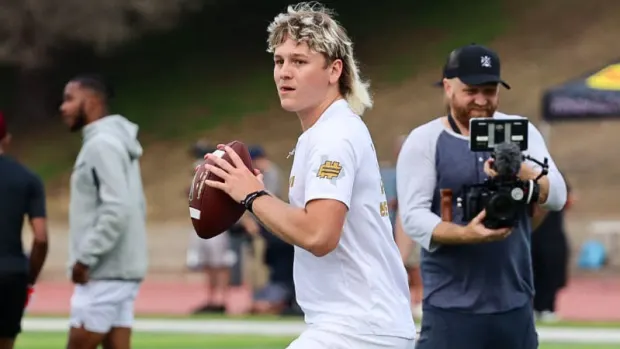What does a frat boy see when a frat boy sees a mullet?
Fashion journalists made much of the mullet in the first half of 2022. The desire is understandable—merely the word mullet has inherent comedy to it, and with the cultural associations (and just plain funny look) of the haircut, mullets make for natural, God’s-honest clickbait. But much of the coverage by the fashion media would have you believe that the mullet is radical—transgressive, bold, usually queer. For most new-mullet iterations, these things are true. Iris Law’s skunk mullet transgresses something, to be sure; everything Lil Nas touches is cheekily queer, and his curly VMA’s hairstyle is no exception.
But not all mullets are woke or progressive. Design historians talk about the inherent meaning vs. collective understanding of things . . . and the Queer ‘n’ Radical mullet is only one half of our collective mullet understanding. In the other half, we’ve got the non-radicals: country boys and posh lads and fraternity guys who’ve been cutting mullets into their heads since at least the 80’s. To these men (note my nouns) and the communities they exist in, mullets are distinctly not gay. They’re peacock-y and hypermasculine, hyper-straight—one of those grunting, chest-thumping, “real men” style choices. They go hand in hand with camouflage pants and Yeti coolers, or white T-shirts with slits cut down the side at football practice. (They’re especially prominent in sports culture, whether football, hockey, soccer, and baseball.)


In Oklahoma, where I grew up, boys grew mullets all the time. Going-too-long-without-a-haircut would turn into a stunt mullet, kept for a week or so as a joke, mostly, before their mother made them cut it back to normal. This frequently happened towards the end of summer breaks: there was often a mullet or two that lasted right till the weekend before the first day of school. These mullets all seemed like in-jokes with “the boys,” choices the Brits might call laddish and that sociologists might say have something to do with homosocial bonding. A mullet, on a Middle American football team, makes you likable. It means you’re sure of yourself, down to clown, confident enough (“man enough”) to pull off an ugly haircut.
Quinn Ewers has cut his hair like this since high school, apparently, telling Sports Illustrated, “I don’t get the haircut to bring the spotlight onto me. I just do it to be myself.” There’s not a lot of interpretation I can put on that, though I’m helped by what Ewers also said to SI about the brands he identifies himself with. “Definitely Wrangler, for sure. Wrangler jeans . . . Maybe some fishing companies. Mossy Oak, Bass Pro, Cabela’s, Academy—stuff like that.” If Ewers’s mullet is about being himself, and if the the sorts of things he likes are huntin’, fishin’, et cetera, than we can infer that to Ewers, a mullet tends to signal a football-playing, outdoorsy good-ol’-boy. That understanding of the mullet seems to me representative of most of (nearly all) the mullets you see in these South and Midwest football teams and small towns, or tailgate parties and fraternity houses.
And this type of mullet—the non-radical—isn’t just American, either . . . on the contrary, it’s mirrored in similar social groups across the Atlantic, on Scottish rugby players (see The Mullets of Edinburgh Uni (@mulletsofedi on Instagram) for some delightful examples), posh boys at boarding school, and young farmers in the Cotswolds. British mullets seem to have a little more resonance with Celtic tribes and rugged warrior-knights (Mel Gibson as William Wallace has a haircut that treads some mystifying line between long hair and mullet) than the American ones do, but both are clearly one thing: conservative. This is a collective understanding of the mullet that some of this year’s journalists forgot about, because it comes from the steady, unchanging swaths of the country, where cultural symbols often have a different definition. When I talked about mullets to a few people in Oklahoma, they were convinced the mullet was “brought back” by Oklahoma State football coach Mike Gundy, who debuted one in 2016, to much local and football-fan furor. I argued this point, obviously, but the discussion was essentially dead on arrival: our cultural reference points varied so greatly that neither of us could ever convince the other. To some people, the mullet is Brooklyn-Carhartt-gay; to others, all mullets are imitations of a college football coach in Stillwater, Oklahoma. I, personally, am just collecting definitions.